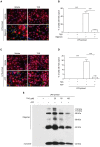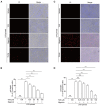Inhibition of NLRP3 Inflammasome Activation and Pyroptosis in Macrophages by Taraxasterol Is Associated With Its Regulation on mTOR Signaling
- PMID: 33679781
- PMCID: PMC7925414
- DOI: 10.3389/fimmu.2021.632606
Inhibition of NLRP3 Inflammasome Activation and Pyroptosis in Macrophages by Taraxasterol Is Associated With Its Regulation on mTOR Signaling
Abstract
Taraxasterol (TAS) is an active ingredient of Dandelion (Taraxacum mongolicum Hand. -Mazz.), a medicinal plant that has long been used in China for treatment of inflammatory disorders. But the underlying mechanism for its therapeutic effects on inflammatory disorders is not completely clear. Inflammasome activation is a critical step of innate immune response to infection and aseptic inflammation. Among the various types of inflammasome sensors that has been reported, NLR family pyrin domain containing 3 (NLRP3) is implicated in various inflammatory diseases and therefore has been most extensively studied. In this study, we aimed to explore whether TAS could influence NLPR3 inflammasome activation in macrophages. The results showed that TAS dose-dependently suppressed the activation of caspase-1 in lipopolysaccharide (LPS)-primed murine primary macrophages upon nigericin treatment, resulting in reduced mature interleukin-1β (IL-1β) release and gasdermin D (GSDMD) cleavage. TAS greatly reduced ASC speck formation upon the stimulation of nigericin or extracellular ATP. Consistent with reduced cleavage of GSDMD, nigericin-induced pyroptosis was alleviated by TAS. Interestingly, TAS time-dependently suppressed the mechanistic target of rapamycin (mTOR) complex 1 (mTORC1) and mTORC2 signaling induced by LPS priming. Like TAS, both INK-128 (inhibiting both mTORC1 and mTORC2) and rapamycin (inhibiting mTORC1 only) also inhibited NLRP3 inflammasome activation, though their effects on mTOR signaling were different. Moreover, TAS treatment alleviated mitochondrial damage by nigericin and improved mouse survival from bacterial infection, accompanied by reduced IL-1β levels in vivo. Collectively, by inhibiting the NLRP3 inflammasome activation, TAS displayed anti-inflammatory effects likely through regulation of the mTOR signaling in macrophages, highlighting a potential action mechanism for the anti-inflammatory activity of Dandelion in treating inflammation-related disorders, which warrants further clinical investigation.
Keywords: ASC speck; NLRP3 inflammasome; dandelion; mTOR; taraxasterol.
Copyright © 2021 Yang, Ye, Chen, Li, Wang, Zhong, Zhong, Zeng, Xu, He and Ouyang.
Conflict of interest statement
The authors declare that the research was conducted in the absence of any commercial or financial relationships that could be construed as a potential conflict of interest.
Figures






Similar articles
-
Paclitaxel Enhances the Innate Immunity by Promoting NLRP3 Inflammasome Activation in Macrophages.Front Immunol. 2019 Jan 29;10:72. doi: 10.3389/fimmu.2019.00072. eCollection 2019. Front Immunol. 2019. PMID: 30761140 Free PMC article.
-
Dimethyl fumarate ameliorates autoimmune hepatitis in mice by blocking NLRP3 inflammasome activation.Int Immunopharmacol. 2022 Jul;108:108867. doi: 10.1016/j.intimp.2022.108867. Epub 2022 May 20. Int Immunopharmacol. 2022. PMID: 35605433
-
Chalcones Display Anti-NLRP3 Inflammasome Activity in Macrophages through Inhibition of Both Priming and Activation Steps-Structure-Activity-Relationship and Mechanism Studies.Molecules. 2020 Dec 16;25(24):5960. doi: 10.3390/molecules25245960. Molecules. 2020. PMID: 33339319 Free PMC article.
-
ALK-JNK signaling promotes NLRP3 inflammasome activation and pyroptosis via NEK7 during Streptococcus pneumoniae infection.Mol Immunol. 2023 May;157:78-90. doi: 10.1016/j.molimm.2023.03.016. Epub 2023 Mar 29. Mol Immunol. 2023. PMID: 37001294 Review.
-
Loop Between NLRP3 Inflammasome and Reactive Oxygen Species.Antioxid Redox Signal. 2022 Apr;36(10-12):784-796. doi: 10.1089/ars.2020.8257. Epub 2022 Jan 17. Antioxid Redox Signal. 2022. PMID: 34538111 Review.
Cited by
-
Taraxasterol mediated autophagy inhibition in pancreatic encephalopathy involves its regulation on L1 cell adhesion molecule.Cytotechnology. 2025 Apr;77(2):72. doi: 10.1007/s10616-025-00721-x. Epub 2025 Mar 4. Cytotechnology. 2025. PMID: 40051886
-
Emerging role and therapeutic implication of mTOR signalling in intervertebral disc degeneration.Cell Prolif. 2023 Jan;56(1):e13338. doi: 10.1111/cpr.13338. Epub 2022 Oct 3. Cell Prolif. 2023. PMID: 36193577 Free PMC article. Review.
-
Dynasore Alleviates LPS-Induced Acute Lung Injury by Inhibiting NLRP3 Inflammasome-Mediated Pyroptosis.Drug Des Devel Ther. 2024 Apr 23;18:1369-1384. doi: 10.2147/DDDT.S444408. eCollection 2024. Drug Des Devel Ther. 2024. PMID: 38681210 Free PMC article.
-
Targeting the NLRP3 by Natural Compounds: Therapeutic Strategies to Mitigate Doxorubicin-Induced Cardiotoxicity.Cell Biochem Biophys. 2025 Sep;83(3):2779-2791. doi: 10.1007/s12013-025-01723-4. Epub 2025 Mar 18. Cell Biochem Biophys. 2025. PMID: 40100343 Review.
-
Taraxasterol suppresses cell proliferation and boosts cell apoptosis via inhibiting GPD2-mediated glycolysis in gastric cancer.Cytotechnology. 2021 Dec;73(6):815-825. doi: 10.1007/s10616-021-00499-8. Epub 2021 Oct 18. Cytotechnology. 2021. PMID: 34776631 Free PMC article.
References
Publication types
MeSH terms
Substances
LinkOut - more resources
Full Text Sources
Other Literature Sources
Miscellaneous

